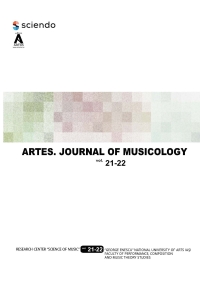Ciprian Porumbescu, creator and protagonist of the Romanian operetta
DOI:
https://doi.org/10.35218/Keywords:
Ciprian Porumbescu, Crai nou operetta, Gherase Dendrino, Lăsați-mă să cânt operettaAbstract
Musical-theatrical pieces of the nineteenth century, propagated by Italian, French and German troops, were an inspiration for Romanian composers. They will create similar fashionable musical theatre genres, in Romanian, for entertainment purposes. Works placed on the border between vaudeville and the lyrical genre can be identified in the creation of the newly emerging genre of operetta: such pieces are the compositions of Alexandru Flechtenmacher, Eduard Wachmann, Eduard Caudella. In the cultural atmosphere of the time, patriotic musician Ciprian Porumbescu (1853-1883) would find the perfect way to put a longstanding artistic wish into practice: to compose an operetta, following the success of his humorous musical-theatre pieces Cisla and Candidatul Linte [Candidate Linte]. A multifarious personality, a lover of folklore and of his nation, Ciprian Porumbescu – one of the founders of the national school of music – contributed to the authenticity and identity of the Romanian musical language through his extensive works; one important contribution is the composition of the first Romanian cultivated operetta Crai Nou [New Moon] (1882). As a tribute to his art, on the centenary of his birth, the creator of the operetta Crai nou becomes the protagonist of the operetta Lăsați-mă să cânt [Let me sing] (1954) by Gherase Dendrino, set during the time of the staging of Porumbescuʼs musical-dramatic work. Crai Nou and Lăsați-mă să cânt are highlights of the Romanian lyrical theatre, from the artistic past and present, and hold their position as musical pieces frequently performed and received with interest and enthusiasm
Downloads
Published
Issue
Section
License
Copyright (c) 2023 ARTES. JOURNAL OF MUSICOLOGY

This work is licensed under a Creative Commons Attribution-NonCommercial 4.0 International License.

